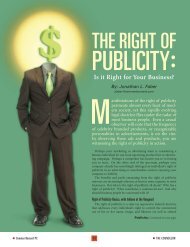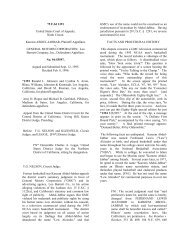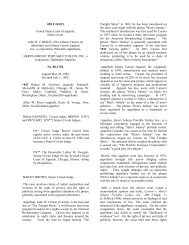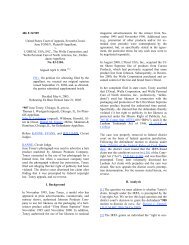Rufo v. OJ Simpson - Right Of Publicity
Rufo v. OJ Simpson - Right Of Publicity
Rufo v. OJ Simpson - Right Of Publicity
Create successful ePaper yourself
Turn your PDF publications into a flip-book with our unique Google optimized e-Paper software.
Page 13<br />
Cal. 3d 573, 584-587, 209 Cal. Rptr. 664, 693 P.2d 243 [victim's<br />
statement, 17 months before the killing, indicating fear of the<br />
defendant was not admissible to show victim's state of mind on the<br />
night of the murder, where the defense identified a third person as the<br />
killer and raised no issue about the victim's attitude toward defendant<br />
or any issue that the killing was accidental or justifiable]; People v.<br />
Ruiz (1988) 44 Cal. 3d 589, 607-610, 244 Cal. Rptr. 200, 749 P.2d 854<br />
[victims' statements of fear of defendant were not admissible to show<br />
their states of mind; victims 1 and 2 were murdered in their sleep and<br />
there was no issue as to their conduct prior to the killings; victim<br />
3's statement did not support prosecution theory of faltering marriage<br />
as motive for killing; but error harmless in light of limiting<br />
instruction]; and People v. Noguera (1992) 4 Cal. 4th 599, 621-622, 842<br />
P.2d 1160 [victim's statement of fear and hatred of defendant was not<br />
admissible to show victim's state [**35] of mind, where her conduct<br />
and state of mind were not relevant to any part of the People's case<br />
nor did the defense raise any issue of her state of mind or behavior<br />
before she was murdered, the entire defense being alibi; but error<br />
harmless in light of limiting instruction].)<br />
[*596] Here, plaintiffs presented specific theories why Nicole's<br />
state of mind about her relationship to <strong>Simpson</strong> was relevant to<br />
<strong>Simpson</strong>'s reasons for killing her.<br />
Other Points<br />
<strong>Simpson</strong> raises several other points about the admission of this<br />
evidence, all without merit. <strong>Simpson</strong> points out that the state of mind<br />
exception to the hearsay rule "does not make admissible evidence of a<br />
statement of memory or belief to prove the fact remembered or<br />
believed." (Evid. Code, @ 1250, subd. (b).) This point is irrelevant<br />
because the evidence was admitted solely for the limited purpose of<br />
showing Nicole's state of mind, not "to prove the fact remembered or<br />
believed." <strong>Simpson</strong> contends the statements in the call to the battered<br />
women's shelter which tended to identify the caller as Nicole (the<br />
caller stated her name was Nicole, she was Caucasian, she was in her<br />
30's, she had been married 8 years but was divorced, she had two<br />
children under 10, she was living in West Los Angeles, and her exhusband<br />
was famous) were themselves inadmissible hearsay. They were<br />
not. They were not admitted "to prove the truth of the matter stated,"<br />
because there was no material disputed issue in the case concerning<br />
Nicole's biographical history. These statements were introduced only as<br />
circumstantial evidence tending to identify the caller. They were<br />
properly admissible for this nonhearsay circumstantial evidence<br />
purpose. ( People v. Herman (1920) 49 Cal. App. 592, 595-596, 193 P.<br />
868; People v. McGaughran (1961) 197 Cal. App. 2d 6, 16, 17 Cal. Rptr.<br />
121; People v. Hess (1970) 10 Cal. App. 3d 1071, 1078-1079, 90 Cal.<br />
Rptr. 268; Dege v. United States (9th Cir. 1962) 308 F.2d 534, 535-<br />
536.)<br />
<strong>Simpson</strong> contends that even if his hearsay and relevance objections<br />
lacked merit, the trial court nevertheless should have excluded this<br />
relevant evidence as unduly prejudicial, pursuant to Evidence Code<br />
section 352. (Fn. 2, ante.) It is for the trial court, in its<br />
discretion, to determine whether the probative value of relevant<br />
evidence is outweighed by a substantial danger of undue prejudice. The<br />
appellate court may not interfere with the trial court's determination







